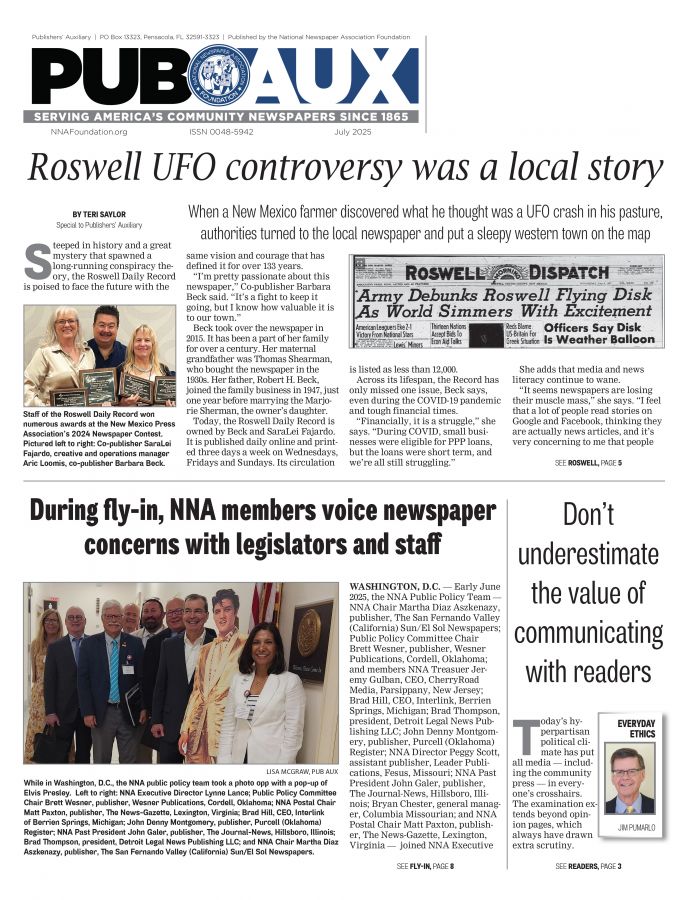NNA opposes 2014 full-service IMb requirement for automation discounts
Jul 2, 2012
By Max Heath
Chair NNA Postal Committee
The National Newspaper Association filed comments June 4 with U.S. Postal Service Product Classification on the proposal to require Full-Service IMb for automation discounts in January 2014. Basic IMb will be required by Jan. 28, 2013, after being delayed nearly four years since it was originally proposed.
The comments explained that NNA has participated in or monitored closely every flats automation work group since flats automation began. Yet NNA members have been more or less excluded from machinability, with only one machine built to handle newspapers well. NNA’s arguments are edited for space below:
• Cost-benefit relationship is lacking. The cost for a small community newspaper to add full-service IMb is priced at cost-prohibitive levels by vendors. Quotes are in the thousands of dollars, more than most newspapers paid for their database/presort software to start with. With 75-85 percent of a community newspapers’ mail presorted to the carrier-route level, in LOT or walk-sequence order, with an equal percentage of that entered at the delivery office, IMb use in a machine-scan is of little to no value to the newspaper. It adds only theoretical value to a minority of pieces mailed by the newspaper.
• Piece-tracking benefit questionable. NNA members don’t know how their mail is handled once it leaves the local entry office. Flexibility rules—intended to create a more efficient automated mailstream—now being further enforced on pieces other than carrier-route, DDU-entered copies, add insult to the injury.
• Advanced IT knowledge required. Full-service users would need staff that is above the IT knowledge of the average community newspaper, most of them privately-owned and operating with limited staff.
• Lack of tools to meet requirements. Today, no reasonable software solution exists for community newspapers to meet the core and most complex full-service IMb requirement of electronic documentation (eDoc) submission. As was true with flat-sorting equipment, Periodicals have been overlooked in this area as apparent by review of the four eDoc options USPS supports:
s Mail.dat, an overly complicated option supported by only the most expensive software packages that is, by USPS own admission, inappropriate for small mailers.
s Mail.XML, which as of the time of this writing excludes Periodical mail because of software glitches with USPS PostalOne! system and has not yet been used by ANY Periodical mailer for actual mailings.
s USPS Postal Wizard, which requires manual entry of postage statement details and excludes Periodical mailings of fewer than 10,000 pieces under DMM 705.24.5.3.
s USPS Intelligent Mail Small Business tool, which excludes Periodical mail, offers no presort, excludes carrier-route discounts, limits address printing options and limits mailing size.
• Free ACS of less value. Although USPS touts the value of free electronic Address Change Service, few community weekly or daily newspapers use electronic ACS. Most subscribers of community newspapers notify the newspaper directly of address changes. Although NNA’s members are severely disappointed by the slow performance of hard-copy address change notices, generally only a small number of subscribers outside the newspaper’s primary market area generate such notices.
• Discount is miniscule. While there is talk of some increase in the discount, now one-tenth of a cent for Periodicals, it is hard to see how the discount could be large enough to close the gap between cost and benefit. NNA believes the value received for full-service IMB argues against it being made mandatory. If its value is not great enough to entice mailers to use it, the forced use is merely a mandatory increase in costs of operation, or a hidden large price increase.
• Service measurement quality. Without the option of automated sorting machine scans for pieces and bundles that are DU-entered, the only data USPS could conceivably capture from a newspaper would have to be a piece or bundle scan at the DDU. If it did, the data tells neither USPS nor the newspaper much that they do not already know: the newspapers are in the delivery office. As to those newspapers traveling outside the DDU, newspaper delivery outside its primary market has been so poor, for so long, that USPS has gradually driven more and more copies out of the mailstream as a percentage of mail distribution. There are fewer and fewer copies to measure, and even if they could be efficiently measured, NNA wonders whether USPS really wants to capture such negative data.
• Newspapers will be forced out of the automation mailstream. To the limited extent that some newspapers can now be run on flat-sorting machines, those opportunities are likely to be lost if full-service is mandated. The cost will likely encourage newspapers to forego seeking automation prices in 2014, removing any chance of improved productivity for handling and further damaging the cost coverage of Periodicals.
• Mandated full service reverses prior management pledges. Mailers were told within the preceding two years by Postmaster General Pat Donahoe, President and Chief Marketing/Sales Officer Paul Vogel, and others, that USPS would never mandate the use of full-service.
“We’ve been using a stick and we want to go to a carrot,” said both officers. After being named chief information officer, Ellis Burgoyne said, “…we will build a world-class system that will make you want IMb, rather than forcing you to do it.” But this year, Burgoyne told NNA that full-service “was always planned as a requirement.” If so, the public statements are diametrically opposed. Clearly, USPS has had an institutional mind change while preferring not to admit it.
In short, we can’t find reasons that are worthwhile, reasonable, affordable or sensible to impose Full-Service IMb. Nor do we think USPS should mislead mailers by promising one thing and then reverting from carrot back to stick. This is a time when the Postal Service should be taking extreme measures to avoid losing more mail volume.
As the postmaster general said to NNA, the carrier has to provide full household coverage, regardless of the amount of mail in the carrier’s sack. Newspapers provide—through highly profitable High-Density and Saturation shoppers and less profitable but highly efficient DDU-entered Periodicals—revenue to help defray the carrier cost.
Trying to drive that mail to IMb when the cost/benefit is so clearly negative and of questionable value in data richness for the Postal Service would be truly counter-productive. © Max Heath 2012
Max Heath, NNA postal chair, is a consultant for Publishing Group of America (American Profile, Relish, & Spry) and Landmark Community Newspapers. E-mail maxheath@lcni.com.







